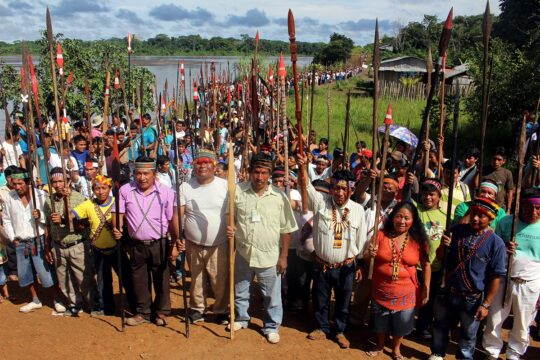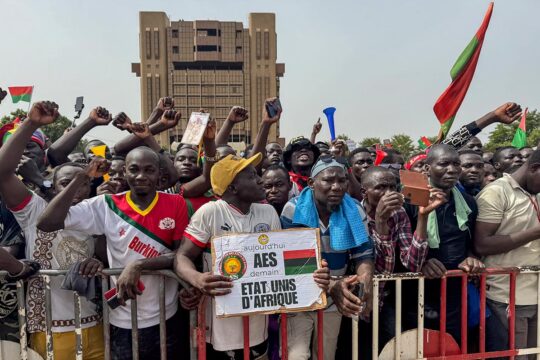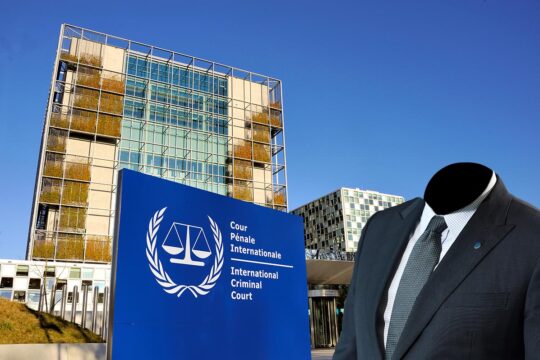Jairo Rivas has a decade of experience working with reparations forms. In the aftermath of Peru’s internal armed conflict, Rivas helped distribute reparations to thousands of victims as Technical Secretary of the Reparations Council, an autonomous body established to implement the comprehensive reparations plan recommended by the country’s Truth and Reconciliation Commission.
Rivas has also worked in Colombia, serving as senior advisor to the Director of the Special Administrative Unit for the Assistance and Comprehensive Reparations of Victims. There, he coordinated the registration process and the implementation of reparations from the internal armed conflict in that country.
In both Peru and Colombia, registrar officers filled out forms following interviews with victims. But how are victims’ stories translated into bureaucratic forms? And how do those forms lead to a measure of justice for victims? ICTJ’s Cristián Correa sat down with Rivas to learn more about his work and discuss how reparations registry processes can most effectively fulfill victims’ rights.
What was the reparation form process like in Peru and Colombia?
Jairo: in both, Peru and Colombia, registrar officers, and not victims themselves, filled out the forms in consultation with victims. In Peru, the officers were Reparation Council staff members or people hired by the different registry offices established by other institutions, like NGOs, municipalities, and churches. The Reparations Council is an autonomous body, directed by a board that includes human rights defenders, an entrepreneur, and retired military officers.
In Colombia, the implementation body, the Victims’ Unit, is a government department. The registrar officers are staff from the institutions that are part of the autonomous control system (Municipal Ombudspersons, the General Procurator of the Nation, and the Office of the Ombudsman).
How were registrar officers selected, trained and supervised?
Jairo: In the case of Peru, registrar officers who were not hired directly by the Reparations Council were trained and supervised only by the Council. The Council trained all officers and they had to pass an exam to guarantee proficiency. The Council verified that the forms were correctly filed too, which helped as quality control. This system responded to demands by victims’ organizations, which requested that some of their members be accepted as registrar officers. They were allowed to serve as officers so long as they passed the exam, which guaranteed the Council and the organizations that all officers had the skills needed to complete the registry.
In Colombia, the officers are from the Defensoría del Pueblo, or municipal comptrollers and ombudspersons. This distinction is the result of historical mistrust of government entities doing registration. The autonomous entities only fill out the forms and the Victims’ Unit is responsible for the verification process. Those autonomous institutions are responsible for training the officers, without interference from the Victims’ Unit. However, the latter was involved in some training sessions to discuss some inconsistencies detected during verification on how forms were filled.
What were the main challenges during the process of filling the forms?
Jairo: The main difficulty for filling the forms in both cases was the difference in terms of narrative logic between victims and the registry process. Victims come to narrate a testimony of their experience. The structure of their narration is that of a story.
The registrar officers have to translate that story into a structure of questions, with a combination of closed and open answers based on the different categories the form demands. Skilled officers were able to move well between both logics, without losing the ability to have empathy for and focus on the victims’ stories. However, that was not always the case: some officers lost the focus (or patience) required to allow the victim to tell their story and trust the officer. In those cases the forms were not able to fully contain all the information needed for the verification process.
What other difficulties did you encounter in trying to gather information on the forms?
Jairo: In both countries there were complaints by some registrar officers about the forms, based on difficulties they experienced filling them out. This led to changes on those versions of the form. Both in Peru and Colombia the first version of the form was determined to be too long. This led to reducing the number of questions, as well as simplifying other procedures. The process stripped away questions not directly relevant to identifying the victim(s) and the violation(s).
What differences emerged when filling out the forms for collective reparations?
Jairo: Registering collective victims also posed a challenge, as it was different than filling individual ones. In both Peru and Colombia, the same officers who registered individual victims also registered collective ones. The difference was that filling out the form required more time, as it involved an exercise of recovering the collective memory of the affected community or group. In most cases this required not just one individual interview, but interviewing several people, or filling them at community assemblies. This could take several hours, and in the case of Colombia even several days.
In both countries there were different collective reparations registry forms, based on the different categories of collective victims. In Peru there was a form for communities (either rural communities or indigenous ones) and hamlets affected by political violence, and another one for organized displaced groups in their areas of resettlement, which was a different category of collectivity included in the reparations program. In Colombia there is a form for groups and communities of victims, and a different one for ethnic communities. The different forms had common variables, but also some specificity to be able to identify the collective victim and the particular consequences.
Registering victims requires evaluating the likelihood that the violations reported happened. In the course of this evaluation process, what positive and negative things did you learn about the forms’ design?As the registries evaluated completed forms, which positive and negative aspects did you find in regards to how the form was designed?
Jairo: In general, the form would be adequate or not depending on its ability to contribute to the verification of the case that allows recognizing the status as victim of a certain violation.
At first, in the case of Peru, there were differences between the department responsible for filling out the forms and the one in charge of determining if the application could be accepted. A first threshold was the verification process, which assessed if forms that were fully completed, with answers to every question. If they questions were not answered, then the forms were not passed to the next stage of the registration process. As it was very difficult to contact the victim again to complete the information, addressing the inconsistencies or information gaps could take a long period.
Addressing this problem required redesigning the process and simplifying the form. This included defining the information that was essential for the forms, including the applicant’s personal information and signature; basic information of the victims (at least their names); and a narration with the basic information about the facts (date, location, description of the facts, and presumed perpetrator); in addition to some supporting documentation. If the form had the rest of the information that was requested, that was good, but not essential, to move the evaluation step. This added fluidity and expediency to the process.
In the case of Colombia, the original version of the form was also reviewed, as it took too long to complete it. The original form contained too many questions that were not directly related with the registration process. Some of these questions were related to information that the State could obtain through other means, or that weren’t directly related to the main goal of the registry.
Which special measures were adopted for registering victims of sexual violence? How can you explain that the Reparations Council was able to register four times more victims of sexual violence than those who were identified previously by the Truth and Reconciliation Commission in Peru?
Jairo: The registry of victims of sexual violence presented the most difficult challenge faced by the registration process. It is a complex issue and adequately responding to it required addressing different aspects. One first dimension is the multiple and different violations that can be considered “sexual violence.”
Initially, in Peru, the only category included was rape. However, the existence of documented cases of forced nudity, sexual slavery, and forced abortions demanded that the Reparations Council to include an additional category of “other forms of sexual violence”, under which those violations could be registered. In Colombia this was not a matter of debate, as the regulations for the reparations program included from the start all forms of sexual violence recognized under international law.
In addition to the legal definition, a second challenge was to help all actors of the process aware of the different types of violations included under this category. Victims who come to register a violation are not always aware or have decided to explicitly include these violations, but sometimes their account of the events include direct or vague allusions to forms of sexual aggressions suffered. In some cases of widows their main concern was to register their murdered relatives, but did not consider themselves direct victims of rape. This restricted perspective could also be applied to the registrar officers, who not always were able to identify this form of violation, as well as the professionals responsible for evaluating the information contained in the forms.
In Peru, training registrar officers and evaluators addressed this limitation, so they could be capable of identifying in the victims’ accounts the possible occurrence of any form of sexual violence. Registrar officers were also trained to use specific questions for these cases; developing basic skills to emotionally support victims narrating these stories; and suggesting that the victim tell the story to officers of the same sex. The other measure adopted was to frequently analyze testimonies by the team of evaluators to determine patterns or indicators that could help improve the ability to identify and analyze these cases.
In most cases victims could not provide any supporting documentation for their account of sexual violence. This created an obstacle for evaluating the cases and including the victims in the registry. In both Peru and Colombia the entities responsible for the registry fully adopted a principle of presumption of good faith by the declarant, accepting the account provided by the victim as sufficient for including them in the registry. This criterion was adopted considering that just narrating the violation was a difficult experience to the victim. Adding to that the burden of having to provide evidence (generally non-existent) was considered a secondary victimization.
Nevertheless, thanks to the adoption of special measures in both Peru and Colombia, and in some cases the support from NGOs with experience working with victims of sexual violence, it was possible to provide support to victims who gave testimony. In these cases, providing a statement at the Registry of Victims was included as part of a process of support to victims that included listening spaces and psychosocial support provided before and after the testimony was given. Even if these experiences had a limited coverage, they show the advantages of collaboration between the State and civil society in benefiting victims.
And what particular measures were implemented for registering children born as result of rape?
Jairo: In the case of Peru, this question was asked to victims, but it was up to them to decide if they wanted to include them and reveal their identity. If they decided to include themselves, their name was incorporated in the registry of victims as a separate victim under that category.
Finally, the main challenge always remains on the victims and their decision to speak out about this especially painful violation, sometimes not even shared with the closest relatives. Even if the prospect of receiving reparation could be an incentive, the whole process of registering the violation acts as a disincentive. The short time allowed for the interview and its instrumental character makes it impossible to provide the conditions of support required for containing all what is internally touched when narrating an experience of sexual violence. There are not easy solutions for this dilemma.





